Plot summary
The story takes place in the context of Trantor's rise from a large regional power to a galaxy-wide empire, unifying millions of worlds. The approximate date is around the year 11,000 AD (originally 34,500 AD, according to Asimov's early 1950s chronology), when the Trantorian Empire encompasses roughly half of the galaxy.
The independent planet Sark rules, and exploits, the planet Florina which orbits the star located nearest to Sark's sun. Sark derives great wealth from kyrt, a natural plant fiber which is extraordinarily useful and versatile, but which cannot be grown on Sark or on any planet other than Florina. The relationship between the two planets is analogous to the situation between European imperial powers and their colonies during the 19th century, or the owners and slaves on the cotton plantations of US South: native Florinians are forced to work in kyrt fields and are treated as an inferior race by the resident Sarkites. They are also lighter-skinned than most humans on other worlds, but this is no longer viewed as significant. Memories of racism on Earth have been lost.
Attempts to break the Sark monopoly and grow kyrt on worlds other than Florina have so far been unsuccessful, because kyrt plants grown on other planets do not produce kyrt, only a useless, inferior form of cellulose; no one understands why. So Sark's wealth depends on its colonial dominance of Florina. The government of Trantor naturally wishes to add the two worlds to its growing empire.
The action centers around Rik, a man suffering from gross amnesia and apparent feeble-mindedness. When Rik gradually starts remembering his past, a political crisis involving Sark, Florina, and Trantor ensues. Rik must dodge planetary law-enforcement agents and interstellar spies as he attempts to learn his own history and identity, which the government of Sark is trying to prevent. Ultimately he learns that before losing his memory he was a "spacio-analyst": a specialized astronaut who gathers samples of the very sparse interstellar gasses in outer space, and determines their composition. (The spacio-analysts' slogan is "We analyze Nothing".) He also finds out that he had discovered that Florina's sun is about to explode into a nova because it is being exposed to a stream of isolated gaseous carbon atoms flowing through its region of space. The carbon atoms, besides causing Florina's sun to approach nova-stage, are also the reason kyrt grows on Florina: they are causing Florina's sun to emit a special energetic wavelength of light which kyrt plants need in order to bio-synthesize the kyrt fiber. Streams of carbon atoms ("carbon currents") are very rare in space; the reason the plants do not make kyrt when grown on planets orbiting other stars is that Florina is the only known habitable planet whose sun is located in the path of a carbon current.
Because losing Florina would mean losing the principal source of Sark's vast wealth, there was an attempt to use the knowledge to blackmail Sark's rulers. His amnesia was caused by the blackmailer's misuse of a mind-altering device called a "psychic probe" in an attempt to calm him down before he could seek other means to make it public. However, once Rik recovers his memory and reveals the effect of the carbon atoms, the conditions that enable kyrt to grow can be easily duplicated anywhere now that they are understood.
Rik also learns that he was born on the planet Earth, which is now radioactive. He suggests that Earth was the planet where humanity first originated, but this hypothesis remains controversial.
Interpretations
The book has often been seen as Asimov's comment on race and the USA's past. [1] But with differences of skin-colour reversed:
"The Currents of Space is best seen as Asimov’s take on race relations in the United States as of the early 1950s, before the rise of the Civil Rights movement...
"Asimov doesn’t really bother to hide his reliance on history here, any more than he did in the Foundation series. He even calls our attention to it by making the inhabitants of Florina fair-skinned and red-haired—paler by far than the inhabitants of most other planets, including Sark. To drive home the point, an official of the Interstellar Bureau of Spatio-analysis (IBS) who is trying to locate the missing Spatio-analyst is noted as being from the planet in the galaxy with the darkest average skin color and wooly hair." [2]
"Asimov has the cotton plantations of North America in mind when describing conditions in Florina but has cunningly reversed the complexions of master and servant. On Florina, lighter-skinned people do the work, and darker folk enjoy the wealth which is produced." [3]

Foundation's Edge (1982) is a science fiction novel by American writer Isaac Asimov, the fourth book in the Foundation Series. It was written more than thirty years after the stories of the original Foundation trilogy, due to years of pressure by fans and editors on Asimov to write another, and, according to Asimov himself, the amount of the payment offered by the publisher. It was his first novel to ever land on The New York Times best-seller list, after 262 books and 44 years of writing.

The Caves of Steel is a science fiction novel by American writer Isaac Asimov. It is a detective story and illustrates an idea Asimov advocated, that science fiction can be applied to any literary genre, rather than just being a limited genre in itself.
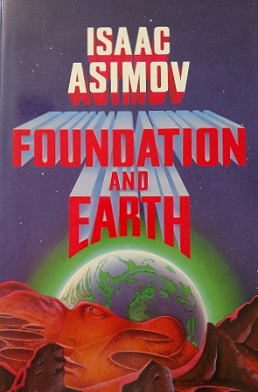
Foundation and Earth is a science fiction novel by American writer Isaac Asimov, the fifth novel of the Foundation series and chronologically the last in the series. It was published in 1986, four years after the first sequel to the Foundation trilogy, which is titled Foundation's Edge.

The Foundation series is a science fiction book series written by American author Isaac Asimov. First published as a series of short stories and novellas in 1942–50, and subsequently in three collections in 1951–53, for nearly thirty years the series was a trilogy: Foundation; Foundation and Empire; and Second Foundation. It won the one-time Hugo Award for "Best All-Time Series" in 1966. Asimov later added new volumes, with two sequels: Foundation's Edge and Foundation and Earth, and two prequels: Prelude to Foundation and Forward the Foundation.
The Galactic Empire series is a science fiction sequence of three of Isaac Asimov's earliest novels, and extended by one short story. They are connected by their early place in his published works and chronological placement within his overarching Foundation universe, set around the rise of Asimov's Galactic Empire, between the Robot and Foundation series to which they were linked in Asimov's later novels.
Galactic empires are a common trope used in science fantasy and science fiction, particularly in works known as 'space operas'. Many authors have either used a galaxy-spanning empire as background or written about the growth and/or decline of such an empire. The capital of a galactic empire is frequently a core world, such as a planet relatively close to a galaxy's supermassive black hole, which has advanced considerably in science and technology compared to current human civilization. Characterizations can vary wildly from malevolent forces attacking sympathetic victims to apathetic bureaucracies to more reasonable entities focused on social progress and anywhere in between.

Nemesis is a science fiction novel by American writer Isaac Asimov. One of his later science fiction novels, it was published in 1989, three years before his death. The novel is loosely related to the future history of his Robot Series, Empire Series, and Foundation Series, into which Asimov attempted to integrate his science fiction output. This novel is connected to Asimov's other works by several ideas from earlier and later novels, including non-human intelligence, sentient astronomical bodies ("Hallucination"), and rotor engines.

Pebble in the Sky is a science fiction novel by American writer Isaac Asimov, published in 1950. This work is his first novel — parts of the Foundation series had appeared from 1942 onwards in magazines, but Foundation was not published in book form until 1951. The original Foundation books are also a string of linked episodes, whereas this is a complete story involving a single group of characters.
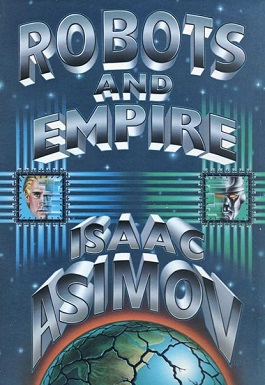
Robots and Empire is a science fiction novel by the American author Isaac Asimov, published by Doubleday Books in 1985. It is part of Asimov's Robot series, which consists of many short stories and five novels.

Second Foundation is the third novel published of the Foundation Series by American writer Isaac Asimov, and the fifth in the in-universe chronology. It was first published in 1953 by Gnome Press.
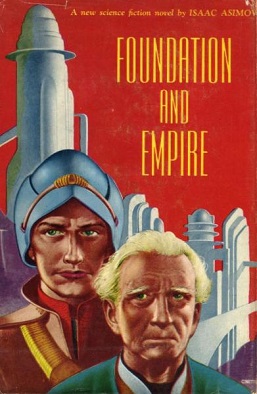
Foundation and Empire is a science fiction novel by American writer Isaac Asimov originally published by Gnome Press in 1952. It is the second book in the Foundation series, and the fourth in the in-universe chronology. It takes place in two parts, originally published as separate novellas. The second part, "The Mule," won a Retro Hugo Award in 1996.
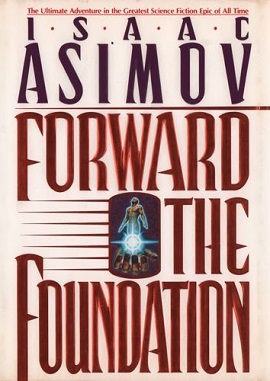
Forward the Foundation is a novel by American writer Isaac Asimov, published posthumously in 1993. It is the second of two prequels to the Foundation Series. It is written in a format similar to that of the original book, Foundation, composed of chapters with long intervals in between, although Forward takes place within only one lifetime. Both books were first published as independent short stories in science fiction magazines.
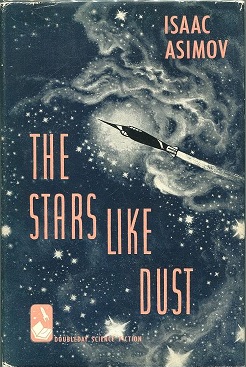
The Stars, Like Dust is a 1951 science fiction mystery book by American writer Isaac Asimov.
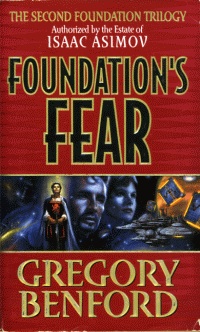
Foundation's Fear (1997) is a science fiction novel by American writer Gregory Benford, set in Isaac Asimov's Foundation universe. It is the first book of the Second Foundation Trilogy, which was written after Asimov's death by three authors, authorized by the Asimov estate.
"Blind Alley" is a science fiction short story by American writer Isaac Asimov. It was first published in the March 1945 issue of Astounding Science Fiction, and later included in the collection The Early Asimov (1972).
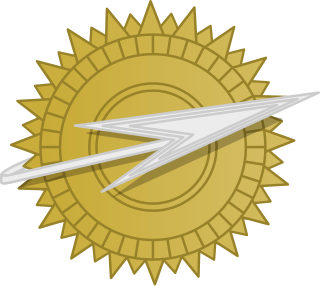
The Galactic Empire is an interstellar empire featured in Isaac Asimov's Robot, Galactic Empire, and Foundation series. The Empire is spread across the Milky Way galaxy and consists of almost 25 million planets settled exclusively by humans. For over 12 millennia the seat of imperial authority was located on the ecumenopolis of Trantor, whose population exceeded 40 billion, until it was sacked in the year 12,328. The official symbol of the empire is the Spaceship-and-Sun. Cleon II was the last Emperor to hold significant authority. The fall of the empire, modelled on the fall of the Roman Empire, is the subject of many of Asimov's novels.
This is a bibliography of the books written or edited by Isaac Asimov, arranged alphabetically. Asimov was a prolific author, and he engaged in many collaborations with other authors. This list may not yet be complete. The total number of books listed here is over 500. Asimov died in 1992 at age 72; a small number of his books were published posthumously.

Ecumenopolis is the hypothetical concept of a planetwide city.
The Foundation universe is the future history of humanity's colonization of the galaxy, spanning nearly 25,000 years, created through the gradual fusion of the Robot, Galactic Empire, and Foundation book series written by American author Isaac Asimov.
In a writing career spanning 53 years (1939–1992), science fiction and popular science author Isaac Asimov (1920–1992) wrote and published 40 novels, 383 short stories, over 280 non-fiction books, and edited about 147 others.














